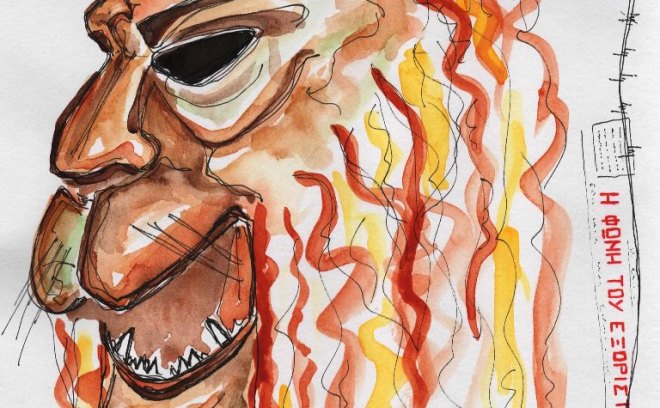Art in Exile: visit to the Museum of Political Exiles "Ai Stratis"
The museum is small, and if you pass by too quickly you will miss it. From the outside you wouldn’t know what an extraordinary part of humanity and human history is kept inside, all for our—the public’s— sake.
There seems to be one thing above all others that human beings give readily to one another, freely and without reserve, and usually without regret — cruelty. All the world’s histories are riddled with it and the twentieth century saw some of the best of the stuff we could muster. Greece is no exception, although her recent dark history is often overlooked.

Sketch of a displayed lion mask created by the exiled artist Katerina Hariati-Sismani, used in a theatrical production on the island by and for the exiles. The text (“Η ΦΟΝΗ ΤΟΥ ΕΧΟΡΙΣΤΟΥ”- “The Voice of the Exile”) is from the exiles’ self-published newspaper, and the barbed-wire is fashioned after a detail from an exile’s wood-block print.
The Museum of Political Exiles “Ai Stratis” has documented, archived, and displayed tangible and intangible memories of just such cruelty which occurred in Greece from the 1920s through to the late 1960s: the exile of “dangerous” individuals in the remotest islands of the country. The extraordinary thing about the Ai Stratis museum is that the Greeks who were internally exiled consciously documented their lives and works on the island with the intention of later creating a place to exhibit their experience. What they were unable to do their descendants took up and completed, and created a place for the public to learn and remember.
The island of Ai Stratis was home to a local population which cohabitated with thousands of political exiles imprisoned there over a span of forty-plus years. The exhibition includes the material remains of the exiles’ life on the island, from a mock-up of a typical male bedroom-hut to artifacts from daily life. What made the biggest impression, touched me the deepest, was that the exhibition isn’t one of photo-documentation, walls of pictures of people emaciated and dying, but one of beautiful art. There is darkness reflected in that art, yes, but there is tenderness, and happiness, joy, entertainment, and hope too. The nature of political exile usually includes a nation’s intelligentsia, artists, writers and poets and Ai Stratis was no exception. That these people continued to live and practice their art, the highest level of humanity, in the face of the lowest level, is what impresses. What’s more is that other exiles who did not already possess a talent for art used their time and the scant resources on the island to learn and to create; the results, as we see displayed in the museum, are some of the most wonderful sculptures, paintings, engravings, prints, poetry and even theatrical masks created in this part of the world in the twentieth century.
The Museum of Political Exiles “Ai Stratis” is a place for the public to witness and interact with the remains of memories, both good and bad, of Greek exiles who transcended their dark circumstance and cruelty. The experience of that museum, and having class conducted in it, was brilliant.
Photos and sketch by Alex Costas.
 Alexandros Costas has a BA (Hons) in Comparative Religious Studies (San Jose State University) and is now a student of the MA in Heritage Management. He worked in study abroad in Greece for over ten years, and through that experience observed the interactions of foreign students with Greek heritage, inspiring him to learn more about heritage and the public.
Alexandros Costas has a BA (Hons) in Comparative Religious Studies (San Jose State University) and is now a student of the MA in Heritage Management. He worked in study abroad in Greece for over ten years, and through that experience observed the interactions of foreign students with Greek heritage, inspiring him to learn more about heritage and the public.


